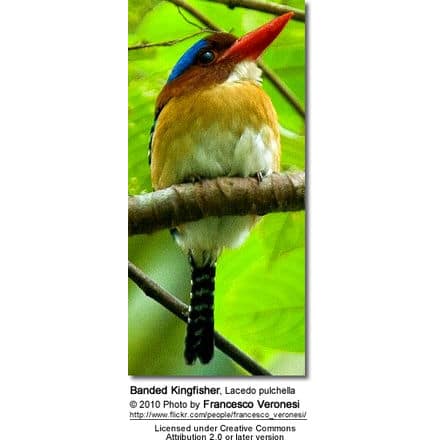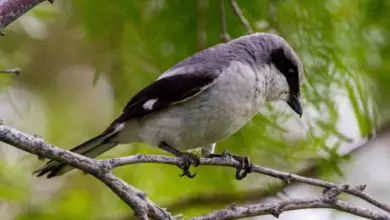Banded Kingfishers
The Banded Kingfishers, Lacedo pulchella, is a tree kingfisher found in the lowland tropical forests of Myanmar, Thailand, Cambodia, Vietnam, and Laos. Malaysia, Sumatra, Java, and Brunei. It is extinct in Singapore. It is the only member of the genus Lacedo.
Kingfisher Information … Kingfisher Species Photo Gallery


Description
The Banded Kingfishers is a 20 cm long kingfisher with a sturdy red bill and a short crest that is slowly raised and lowered. It shows striking sexual dimorphism compared to most of its relatives.
The adult male has a chestnut forehead, cheeks nape, and a bright blue cap. The rest of the upper parts, wings, and tail are black with blue bands. The breast, flanks, and undertail are rufous, and the central belly is white.
The adult female is equally striking, with black-and-rufous-banded upperparts, and white underparts with some black bars on the chest and flanks. Young birds are duller than the adults of the same sex, have brown and orange bills, and dusky barring on the underparts.
Calls / Vocalizations
The call is a long whistled wheeeoo followed by 15 repetitions of chiwiu in 17 seconds, the second syllable gradually fading away. The Banded Kingfisher will respond to imitations of its call.
There are three subspecies:
- L. p. pulchella, the nominate race, breeds in Malaysia south of 7oN, Sumatra and Java.
- L. p. amabilis breeds from northern Malaysia northwards. It is slightly larger than the nominate form. The male has a blue nape, and the female is more rufous than the pulchella.
- L. p. melanops breeds in Brunei. The male has a black forehead, cheeks, and nape.
Behavior
This is a bird of lowland rainforest found up to 1700 m in Brunei, but normally below 1100 m altitude in the rest of its range. Unlike most kingfishers, it does not need pools or streams in its territory.
The nest is a hole in a rotting tree trunk, or sometimes in the spherical nest of tree termites. Two to five white eggs are laid.
The Banded Kingfisher hunts large insects and occasionally small lizards, usually taken in the trees, but sometimes from the ground.
Status
This species is uncommon but widespread in much of its range. It is rare in Java, very rare in Sumatra, and extinct in Singapore.
References
- Fry, Fry and Harris, Kingfishers, Bee-eaters, and Rollers ISBN 0-7136-1410-8
- Robson, Craig. A Field Guide to the Birds of Thailand ISBN 1843309211
Beauty Of Birds strives to maintain accurate and up-to-date information; however, mistakes do happen. If you would like to correct or update any of the information, please contact us. THANK YOU!!!


